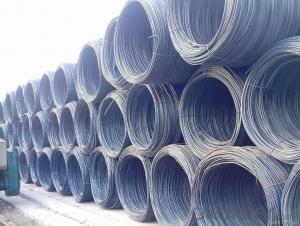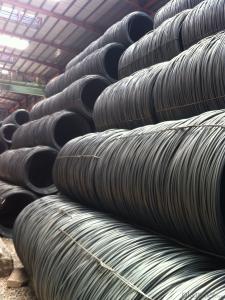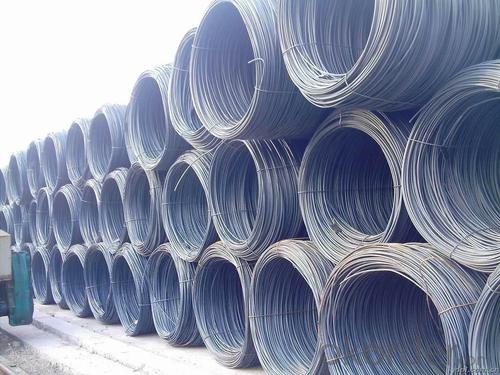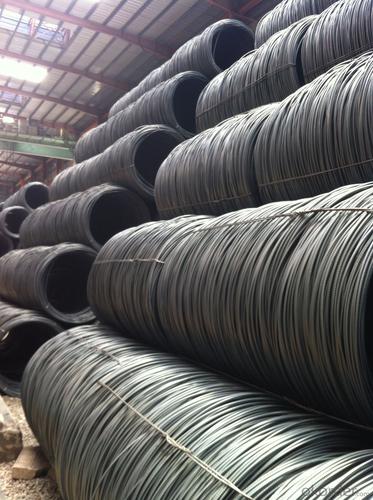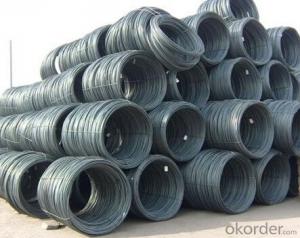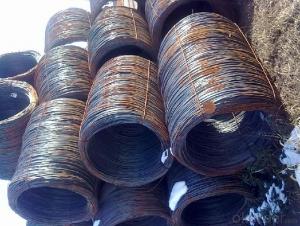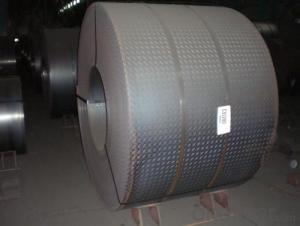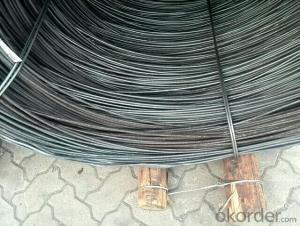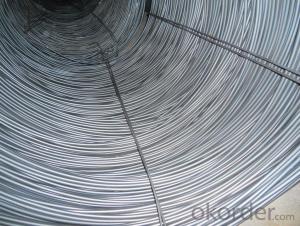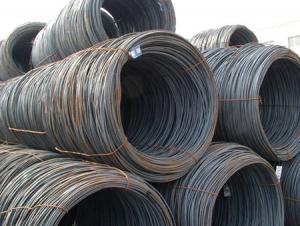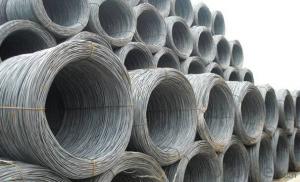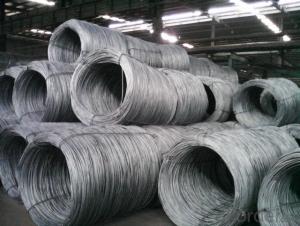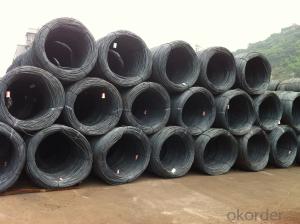Steel Wire Rods in Grade ASTM SAE1006-1018
- Loading Port:
- Tianjin
- Payment Terms:
- TT OR LC
- Min Order Qty:
- 25 m.t
- Supply Capability:
- 10000 m.t/month
OKorder Service Pledge
OKorder Financial Service
You Might Also Like
OKorder is offering wire rods at great prices with worldwide shipping. Our supplier is a world-class manufacturer of steel, with our products utilized the world over. OKorder annually supplies products to European, North American and Asian markets. We provide quotations within 24 hours of receiving an inquiry and guarantee competitive prices.
Product Applications:
After hot-rolled the products shaped into coil and delivery as finished product, including round, square,rectangular, hexagonal and so on. Since most of the products are round, it is generally called wire rod. Carbon steel wire rod is widely used in construction and manufacturing. Carbon steel wire rod is mainly used for reinforcement of reinforced concrete and welded structure or reprocessed (roberts , nail, etc.) materials, especially used to produce wire drawing, welding electrode, nails, spring, electronic, precise machinery parts and so on.
Product Advantages:
OKorder's Wire rods are durable, strong, and resist corrosion.
Main Product Features:
· Premium quality
· Prompt delivery & seaworthy packing (30 days after receiving deposit)
· Corrosion resistance
· Can be recycled and reused
· Mill test certification
· Professional Service
· Competitive pricing
Product Specifications:
Manufacture: Hot rolled
Grade: SAE1006-SAE1018
Certificates: ISO, SGS, BV, CIQ
Packaging: Export packing, nude packing, in coils
Grade | Chemical Composition (%) | |||||
C | Mn | S | P | Si | B | |
SAE1008B | 0.10max | 0.32max | 0.045max | 0.040max | 0.30max | 0.0008min |
Mechanical properties | ||||||
Yield strength(N/mm2) | Tensile strength(N/mm2) | Elongation (%) | ||||
≥195 | 350-380 | ≥32 | ||||
FAQ:
Q1: Why buy Materials & Equipment from OKorder.com?
A1: All products offered byOKorder.com are carefully selected from China's most reliable manufacturing enterprises. Through its ISO certifications, OKorder.com adheres to the highest standards and a commitment to supply chain safety and customer satisfaction.
Q2: How do we guarantee the quality of our products?
A2: We have established an advanced quality management system which conducts strict quality tests at every step, from raw materials to the final product. At the same time, we provide extensive follow-up service assurances as required.
Q3: The products are invoicing on theoritical weight or on actual weight?
A3: Usually, on actual weight.
Q4: How soon can we receive the product after purchase?
A4: Within three days of placing an order, we will begin production. The specific shipping date is dependent upon international and government factors, but is typically 7 to 10 workdays.
Images:
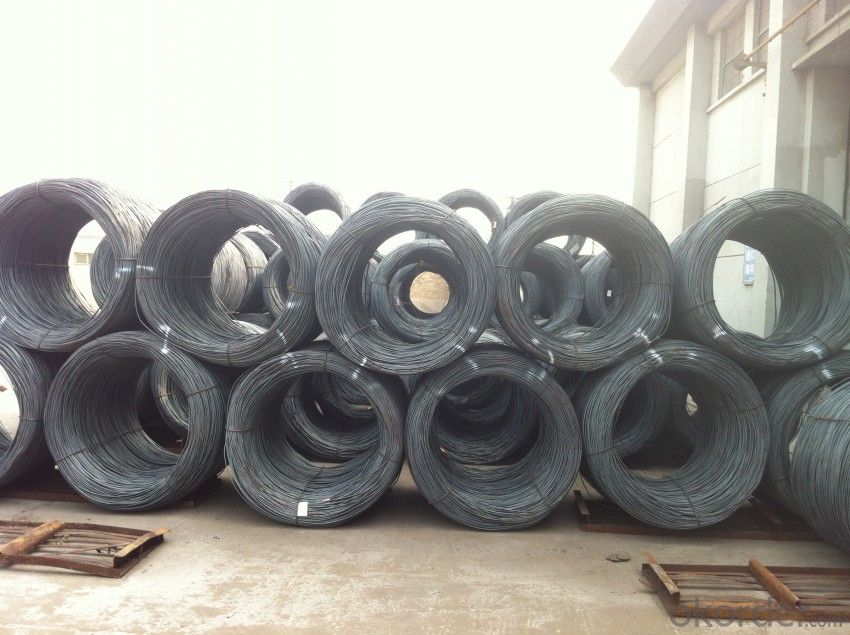
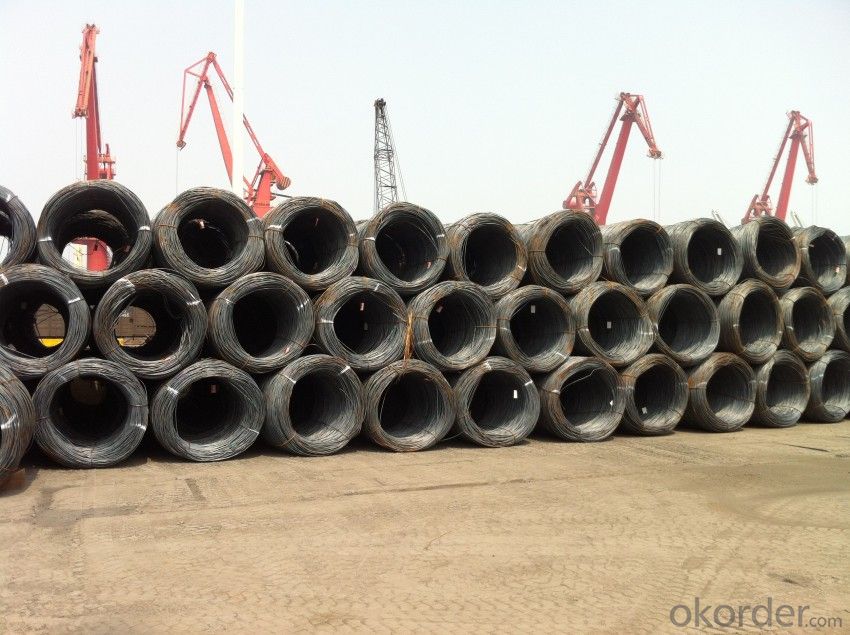
- Q: How is steel wire rod used in the manufacturing of wire forms for furniture?
- The manufacturing of wire forms for furniture heavily relies on steel wire rod, a vital component. This wire rod is utilized in various ways to produce robust and long-lasting wire structures, which are essential for constructing furniture pieces. To begin with, steel wire rod acts as the main material for manufacturing the wires used in furniture production. Typically, the wire rod is drawn through a series of dies to achieve the desired diameter and shape. These wires are then employed to create the framework of different furniture items, including chairs, tables, and shelving units. Furthermore, steel wire rod is frequently employed to fabricate furniture springs. Springs are crucial in furniture construction as they provide support, comfort, and flexibility to the seating or bedding surface. By utilizing steel wire rod, manufacturers can fabricate high-quality springs that are resilient and long-lasting. Additionally, steel wire rod is used to reinforce specific parts of furniture. For instance, it can be integrated into the structure of a chair to enhance the stability of the legs or the backrest, preventing potential damage or breakage. Moreover, steel wire rod serves as a medium for creating decorative elements in furniture design. It can be bent, twisted, or shaped into intricate patterns or designs, enhancing the aesthetics of the furniture piece. These decorative wire forms can serve as accents, handles, or even the main design feature of the furniture item. In conclusion, steel wire rod plays a critical role in the production of wire forms for furniture. Its strength, versatility, and durability make it an ideal material for creating the framework, springs, reinforcements, and decorative elements needed in furniture construction.
- Q: How is steel wire rod used in the manufacturing of barbed wire?
- Steel wire rod is a crucial component in the manufacturing of barbed wire as it serves as the base material for creating the barbs. The steel wire rod is first drawn into thin wires, which are then twisted and shaped into sharp points or barbs. These barbs are then attached to a central wire, forming the characteristic barbed wire structure. This process ensures that barbed wire is strong, durable, and effective for various applications such as security fencing, livestock containment, and military purposes.
- Q: How are steel wire rods used in the production of screws and bolts for mechanical assemblies?
- Steel wire rods are an essential component in the production of screws and bolts for mechanical assemblies. These wire rods are made from high-quality steel that provides the necessary strength and durability required for these fasteners. The production process begins with the wire rods being heated and then passed through a series of rollers to reduce their diameter. This process, known as wire drawing, ensures that the wire rods achieve the desired thickness and smoothness required for manufacturing screws and bolts. The wire rods are then cut into smaller lengths, which will serve as the foundation for individual fasteners. Next, the wire rods undergo a cold heading process. This involves placing the wire rod into a die and applying pressure to shape it into the desired screw or bolt head. Cold heading not only forms the head but also creates the necessary thread on the shank of the fastener. This threading is crucial as it allows the screws and bolts to securely fasten different components together. After the cold heading process, the screws and bolts may undergo additional treatments to enhance their performance. These treatments can include heat treatment to further strengthen the steel, plating or coating for corrosion resistance, or even specific coatings for improved lubrication during assembly. Once the screws and bolts are fully formed and treated, they are packaged and prepared for distribution to various industries that rely on mechanical assemblies. These fasteners play a crucial role in holding together different components of machinery, vehicles, and structures, ensuring their stability and functionality. In summary, steel wire rods are utilized in the production of screws and bolts by undergoing processes such as wire drawing and cold heading. These processes shape the wire rods into the desired fastener shape with threaded shanks. The resulting screws and bolts are then used in mechanical assemblies, providing a secure and reliable means of joining components together.
- Q: What are the different types of heat treatment processes for steel wire rod?
- There are several different types of heat treatment processes for steel wire rod, including annealing, normalizing, quenching and tempering. Annealing involves heating the steel to a specific temperature and then slowly cooling it to make it softer and more ductile. Normalizing is similar to annealing, but the cooling process is done in still air instead of slowly. Quenching involves rapidly cooling the steel by immersing it in a liquid, such as oil or water, to make it harder and stronger. Tempering is a process that follows quenching, where the steel is reheated to a lower temperature to reduce its brittleness and improve its toughness.
- Q: What are the different cutting methods for steel wire rod?
- Steel wire rods can be cut using various methods, depending on specific requirements and desired outcomes. Some commonly used cutting methods include: 1. Shearing: Wire rods can be cut using shears or a cutting blade either manually or with machinery, depending on the thickness and length of the rod. 2. Sawing: Saw blades or band saws are used to cut through thicker wire rods or when a precise and clean cut is needed. 3. Abrasive cutting: This method involves using an abrasive disc or wheel to grind through thin wire rods, providing a smooth and precise cut. 4. Flame cutting: Also known as oxy-fuel cutting, this thermal method uses a high-temperature flame created by combining oxygen and a fuel gas. It is commonly used for thick wire rods and offers a fast and efficient cutting solution. 5. Laser cutting: By using a focused laser beam to melt and vaporize the wire rod, laser cutting provides highly precise and efficient cuts. It is often employed for intricate patterns or when a high level of precision is required. These are just a few of the available cutting methods for steel wire rods. The choice of method depends on factors such as the rod's thickness and length, desired outcome, and available equipment and resources.
- Q: What are the main factors influencing the choice of steel wire rod quality standards?
- The main factors influencing the choice of steel wire rod quality standards are: 1. Application requirements: The intended use of the steel wire rod plays a significant role in determining the quality standards. Different industries have specific requirements for strength, durability, corrosion resistance, and other mechanical properties. The choice of quality standards depends on meeting these application-specific needs. 2. National and international regulations: Steel wire rod quality standards are often regulated by national and international bodies such as ASTM (American Society for Testing and Materials), ISO (International Organization for Standardization), and EN (European Norms). Compliance with these standards is essential to ensure that the steel wire rod meets the necessary safety and performance requirements. 3. Customer specifications: Customers may have their own specific quality standards or requirements that need to be met. These specifications can include chemical composition, mechanical properties, surface finish, and dimensional tolerances. Meeting these customer specifications is crucial to ensuring customer satisfaction and maintaining long-term business relationships. 4. Quality assurance and control: Manufacturers and suppliers of steel wire rod often have their own internal quality assurance and control processes. These processes may include inspections, testing, and certifications to ensure that the wire rod meets the required quality standards. The choice of quality standards is influenced by the manufacturer's ability to meet these internal quality control measures. 5. Cost considerations: The choice of steel wire rod quality standards can also be influenced by cost considerations. Higher quality standards may require more stringent manufacturing processes, testing, and inspections, which can result in higher production costs. Manufacturers and customers need to strike a balance between quality and cost to ensure competitiveness in the market. Overall, the main factors influencing the choice of steel wire rod quality standards are application requirements, national and international regulations, customer specifications, quality assurance and control processes, and cost considerations. By considering these factors, manufacturers and customers can select the appropriate quality standards to meet their specific needs and ensure the desired performance and reliability of the steel wire rod.
- Q: What are the different hardness testing methods for steel wire rod?
- Steel wire rods can be evaluated for hardness using various methods. These include: 1. The Rockwell Hardness Test, which is widely used. It involves creating an indentation on the rod's surface using a diamond cone or steel ball. The depth of the indentation is then measured and correlated to a hardness value. 2. The Brinell Hardness Test, which also involves creating an indentation on the rod's surface. However, a larger ball is used compared to the Rockwell test. The diameter of the indentation is measured and converted to a hardness value. 3. The Vickers Hardness Test, which utilizes a square-based diamond pyramid indenter to make an indentation on the rod's surface. The size of the indentation is measured, and the hardness value is calculated based on the applied load and the indentation's surface area. 4. The Knoop Hardness Test, which is similar to the Vickers method but uses a rhombic-based diamond indenter. The length of the indentation is measured, and the hardness value is calculated based on the applied load and the projected area of the indentation. 5. Microhardness Testing, which involves using a microhardness tester to evaluate the hardness of the steel wire rod at a microscopic level. This method is particularly useful for assessing the hardness of different regions within the rod or for analyzing smaller samples. By employing these various hardness testing methods, manufacturers can obtain valuable information about the mechanical properties of steel wire rods. This allows them to ensure that the rods meet the necessary hardness specifications for their intended applications.
- Q: What are the main producers of steel wire rod?
- The main producers of steel wire rod include major steel companies such as ArcelorMittal, Nippon Steel Corporation, POSCO, Baosteel Group, and Tata Steel.
- Q: What are the different types of steel wire rod coatings used for improved wear resistance?
- There are several types of steel wire rod coatings used for improved wear resistance. Some of the commonly used coatings include zinc, galvanized, zinc-aluminum, and epoxy coatings. Each of these coatings provides different levels of protection against wear and corrosion, depending on the specific application and requirements.
- Q: How is the quality of steel wire rod measured?
- To assess the mechanical properties, chemical composition, and overall performance of steel wire rod, a series of tests and evaluations are conducted. These evaluations determine the quality of the rod based on several key parameters: 1. Tensile Strength: This test measures the rod's ability to withstand stress before breaking or deforming. It indicates its capacity to bear weight and resist tension. 2. Yield Strength: This test determines the stress level at which permanent deformation occurs. It indicates the rod's ability to return to its original shape after being subjected to stress. 3. Elongation: By measuring the percentage increase in length before the rod breaks under tension, this test provides insights into its ductility and ability to elongate without compromising integrity. 4. Hardness: This test assesses the rod's resistance to indentation or scratching, indicating its strength and durability. 5. Chemical Composition: The steel wire rod's composition is analyzed to ensure it meets the required standards. This involves evaluating levels of carbon, manganese, silicon, sulfur, phosphorus, and other alloying elements. 6. Surface Quality: Visual inspection and sometimes microscopic analysis are conducted to detect defects like cracks, scratches, or impurities. A smooth and clean surface is essential for optimal performance. 7. Dimensional Accuracy: The rod's diameter and length are measured to ensure they adhere to specified tolerances. Deviations from the required dimensions can impact the rod's usability in various applications. 8. Microstructure Analysis: This examination involves detailed observation of the rod's internal structure using microscopy. It helps identify abnormalities such as grain size, inclusions, or segregation that may affect its strength and performance. Through these tests and evaluations, manufacturers can ensure that steel wire rod meets the necessary quality standards and is suitable for its intended applications, such as manufacturing wire products, reinforcing materials, or springs.
Send your message to us
Steel Wire Rods in Grade ASTM SAE1006-1018
- Loading Port:
- Tianjin
- Payment Terms:
- TT OR LC
- Min Order Qty:
- 25 m.t
- Supply Capability:
- 10000 m.t/month
OKorder Service Pledge
OKorder Financial Service
Similar products
Hot products
Hot Searches
Related keywords
